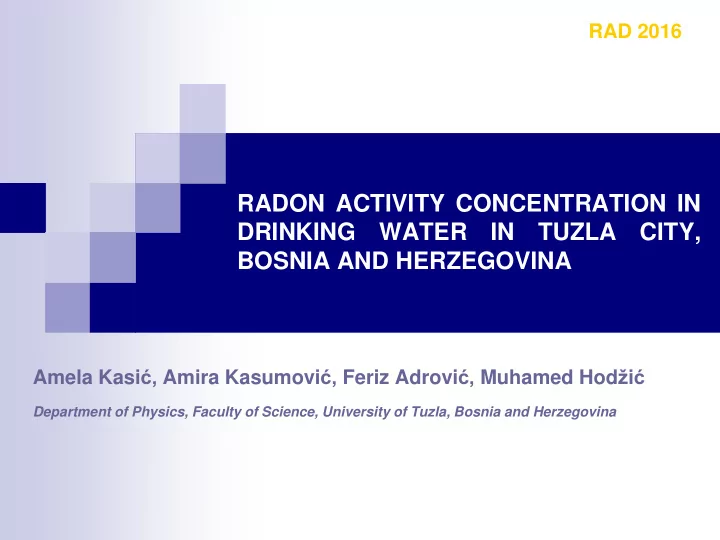

RAD 2016 RADON ACTIVITY CONCENTRATION IN DRINKING WATER IN TUZLA CITY, BOSNIA AND HERZEGOVINA Amela Kasi ć, Amira Kasumovi ć, Feriz Adrovi ć, Muhamed Hod ž i ć Department of Physics, Faculty of Science, University of Tuzla, Bosnia and Herzegovina
RAD 2016 INTRODUCTION
RAD 2016 Radon is a colorless, odorless natural radioactive gas. Radon is considerably more soluble in water than the lighter noble gases, about 15 times as soluble as helium and neon. Radon comes from the natural decay of uranium, present in granite rocks and soil. It may dissolve into groundwater, which can be extraced from bedrock (drilled well) or from a soil aquifer (dug well).
RAD 2016 Ingested radon is removed from the body through exhalation while the longer-lived decay products are eliminated by urinary and fecal excretion. Ingested water eventually passes through the stomach into the small intestine, where the remaining radon and decay products are released from the water and transferred to blood. They then circulate within the body; most are released from the blood into the lung and exhaled, but some remain in the blood and accumulate in organs and tissues, which receive an absorbed dose from alpha, beta, and gamma radiation.
RAD 2016 Radon gas can dissolve in groundwater and later be released into the air during such normal household activities as showering, dishwashing and doing laundry. The concentration in ground water from bedrock is low in areas where uranium concentrations in the rocks are low (diorite, gabbro and basic vulcanites, limestone, sandstone and shale). Radon concentrations in groundwater may vary between 1 and 50 Bq/l in sedimentary rocks, but concentrations in surface waters are low, usually below 1 Bq/ l.
RAD 2016 MATERIALS AND METHODS
RAD 2016 Study area Measurement of radon activity concentration in samples of water from wells was carried out in 11 different locations in Tuzla City, Bosnia and Herzegovina. Thy City of Tuzla is located in the Jala basin, in the region of the northern Bosnia. The emergence of Tuzla basin is connected to activities occurred in several phases after Mesozoic, causing various conditions of sedimentation.
RAD 2016 222 Rn in drinking water is principally a problem for private well owners. At the investigated locations, private wells are often drilled or dug to supply water to individual households in Tuzla City that cannot be connected to a public water supply. Depth of drilled wells ranged between 6-9 meters in the investigated areas.
RAD 2016 Experimental set-up The measurements of radon activity concentration is done with AlphaGUARD and AquaKIT equipment. Also, the pH of the water samples was measured using electronic pH meter. The radon detector of the AlphaGUARD is based on a design- optimized pulse ionization chamber. Measuring range of this device for radon activity concentration is from 2-2 × 10 6 Bqm -3 , while the temperature range is from -10 to 50 °C.
RAD 2016 In combination with the radon monitor and AlphaPUMP electronic pumping unit AquaKIT allows to determine the radon concentration in water samples directly and precisely. The main condition for correctness and exactness of measurement of radon activity concentration in water is appropriate sampling. The AquaKit is an attachment consisting of two glass vessles, a battery-operated pump and related piping.
RAD 2016 For determination of radon concentration in water sample, the following equation was used: V V System Sample C k C air 0 V Sample C Water 1000
RAD 2016 The final result is calculated taking into consideration the value of diffusion coefficient, which depends on temperature: 0 . 052 T 0 . 106 0 . 405 k e Based on the results of the measurements radon activity concentration in the water sample was calculated annual effective ingestion dose of radon, using the equation H C D G ing water
RAD 2016 RESULTS AND DISCUSSION
RAD 2016 Table 1 Values of pH, water temperature and diffusion coefficient of radon in drinking water samples in Tuzla City, Bosnia and Herzegovina T ( º C) No. Locality Type of well pH k 1. Moluhe drilled 16 7.1 0.28 2. Solina 1 drilled 19 7.6 0.26 3. Solina 2 drilled 19 7.3 0.26 4. Solina 3 drilled 13 7.3 0.31 Brđani 5. drilled 18 7.5 0.26 6. Obodnica 1 drilled 12 7.5 0.32 7. Obodnica 2 drilled 16 7.1 0.28 8. Lipnica drilled 16 6.6 0.28 9. Grabovica 1 drilled 13 7.1 0.31 10 Grabovica 2 drilled 17 7.7 0.27 11. Sepetari drilled 18 7.3 0.26
RAD 2016 Table 2 Values of radon activity concentration and annual effective dose in investigated water samples in Tuzla City, Bosnia and Herzegovina No. Locality Type of well C w H ing ( μSvy -1 ) (mBqL -1 ) 1. Moluhe drilled 521 0.11 2. Solina 1 drilled 301 0.06 3. Solina 2 drilled 182 0.04 4. Solina 3 drilled 1075 0.22 Brđani 5. drilled 766 0.16 6. Obodnica 1 drilled 2356 0.49 7. Obodnica 2 drilled 557 0.12 8. Lipnica drilled 2368 0.50 9. drilled 438 0.09 Grabovica 1 10 drilled 468 0.09 Grabovica 2 11. drilled 727 0.15 Sepetari
RAD 2016 CONCLUSION
RAD 2016 Results of these measurements indicate that the radon activity concentrations in the investigated water samples are well below the recommended concentration limits. In this paper, we have shown a significant influence of temperature on the level of radon concentration in the water. These results does not exceed the value of 11.1 BqL -1 recommended by Environmental Protection Agency for drinking water.
Recommend
More recommend